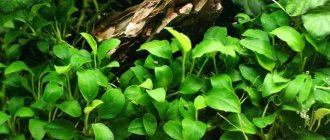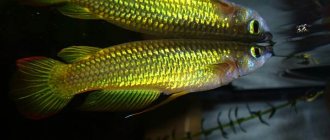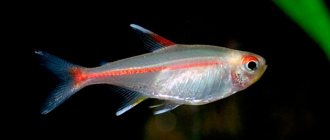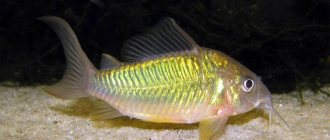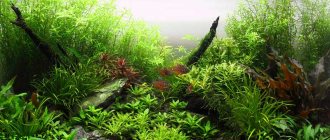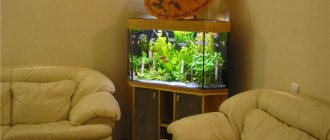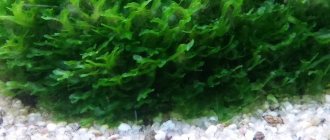5
(1)
Creating interesting and captivating compositions in an aquarium is an art. There are a lot of different rules and means that will allow you to realize your wildest ideas. One of the most common decorative elements in an aquascape is plants. It is not surprising, because in the world there are many varieties of underwater flora that have the most unimaginable shapes and colors. For example, glossostigma is considered one of the most interesting plants.
Growing and care
Glossostigma takes root well in shallow aquariums. When caring for a plant, it is important to prevent adjacent stems from intertwining or overlapping. Dense placement leads to gradual death.
The stems are trimmed every time their height reaches 3-4 centimeters. When planting, the glossostigma should not press against the glass. It needs to be moved a few centimeters away from the front wall.
The lower leaves must be trimmed regularly, otherwise they will turn yellow and fall off. Old dying leaves may become affected by algae. Affected areas of plants must be removed, otherwise the algae will continue to spread. If sprouts are accidentally pulled out of the substrate, there is no need to try to secure them.
In order for glossostigma to quickly take root in the aquarium and begin to grow, you need to consider several recommendations:
- when planting glossostigma, it is worth adding a nutrient substrate to the bottom layer of soil;
- It is advisable to grow glossostigma with a CO2 supply system (a high concentration of carbon dioxide is especially important in intense light);
- the optimal substrate for glossostigma is aquasoils (a porous soil that reduces the acidity of water);
- To combat algae, the use of snails and fish is effective. To stop the glossostigma from overgrowing, the aquarium is populated with neretina and platies.
Glossostigma povoinicheva in aquarium design
For the first time, Takashi Amano used this representative of the Norichnikov family to decorate home ponds. This was around 1980, and since then the plant has not given up its position.
It is used mainly for foregrounds. There may be several landing options:
- Sprinkle the whole branch with soil.
- Plant the plant in bunches every 2 cm. This method guarantees a uniform “carpet” in a short time.
- This option is not for beginners, but the results of your work will be amazing! It is necessary to plant Eleocharis parvula or needle grass and glossa, and allow it to grow for some distance into Eleocharis. At the border between these plants you can see a very interesting effect.
There is no need to be afraid that plants will strangle each other - this will not happen.
If there is enough carbon dioxide in the aquarium, then air bubbles will accumulate on the leaves of Glossostigma elatiniformes (don’t be alarmed, it’s still the same plant), which will create a stunning effect.
The disadvantages of glossa include its tendency to grow vertically. This sometimes happens, even if the aquarium has very bright lighting, a lot of CO2, excellent soil and timely weeding.
Requirement for fertilizers
Glossostigma absorbs soil and liquid iron- and potassium-containing fertilizers well. The lack of these elements can be determined by the appearance of the plant - it begins to turn yellow. With a lack of fertilizing with nitrogen, phosphorus and magnesium, glossostigma becomes overgrown with algae. To accelerate plant growth, it is recommended to supply carbon dioxide (up to 20-30 milligrams per liter of water).
Among liquid fertilizers, any complex fertilizers are suitable for feeding glossostigma, for example:
PRODIBIO BioVert Plus (2.5 ml for every 100 liters of water)
TROPICA Premium Nutrition (5 ml for every 50 liters of water)
DENNERLE V30 (3 ml for every 100 liters of water)
Description
People often use large and medium-sized plants in aquariums because they provide great aesthetic appeal and can serve as a “strong point.” However, there is also a flora that is used to support the overall design, fill the scape and give it perfection. Glossostigma Elatinoides is one of these.
This plant appeared in the aquarium hobby relatively recently. In the 80s, its advantages were revealed to the world by Takashi Amano, a famous master of design, famous for his natural aquariums. Since then, this flora has firmly established itself in the TOP aquarium hobby and is considered one of the most desirable ground cover plants.
Its homeland is Tasmania, Australia and New Zealand. This is a small creeping flora. It can reach about 3 cm in length, but if there is poor lighting in the aquarium, the stems can stretch up to 10 cm, but in this case the plant loses its attractiveness.
Horizontal shoots are long. This flora actively grows and covers the lower layers of the aquarium, clinging to the ground. Glossostigma has a creeping stem, at the end of which there are several oval green leaves, the width of which does not exceed 5 mm and the length not exceeding 10 mm. Small roots grow from each leaf node. The distance between them is about 2 cm.
Reproduction
Glossostigma reproduces using a creeping stem from which roots grow. The plant is divided into whorls of two leaves. In the process of transplanting a young plant into an aquarium, tweezers are used. During planting, the stem is buried in the soil (otherwise the plant will float).
If the immersion is successful, the roots are attached to the ground. The bunch is divided into several parts, each of which is planted at a distance of 2-3 centimeters from each other. When glossostigma takes root, it creates a smooth carpet covering the bottom of the aquarium.
Glossostigma
Glossostigma
Glossostigma povoinichova is the queen of ground cover aquarium plants! Since time immemorial, aquascapers all over the world have been using it in the foreground of their masterpieces.
Glossotigma is a small plant; the mat it forms is very thin. The thickness of the glossostigma mat can be up to 1 centimeter! Glossostigma has round, light green leaves up to 5 mm in size. The length of the internode is about 1 cm, but can reach 5 cm - that is, it “spreads” in all directions quite actively, which introduces some features into the care of the glossostigma mat.
If you need to keep clear boundaries of the mat, you should cut off actively spreading stems. Otherwise, glossostigma may occupy a much larger area in the aquarium than planned.
Glossostigma is planted in separate whorls of two leaves at a distance of 1-2 cm from each other. This is quite enough to get a mat of glossostigma in a month under the right conditions.
Glossostigma is considered an unpretentious aquarium plant. It can grow even in aquariums without CO2 supply, minimal nutritional supplementation and even without high levels of lighting. But!!! In such unfavorable conditions, glossostigma will not spread along the ground. In aquascaping, glossostigma can be used only under conditions of a high level of lighting, and a dense mat can only be obtained with lighting from 1 watt/l (80-90 lm/l), with a daylight duration of at least 10 hours. A little less light and the glossostigma mat will be thinner. As with all aquarium plants, such a high level of lighting leads to the need for a plentiful supply of CO2 (20-30 mg/l) and fertilizers. Also, in order for the glossostigma to have a rich green color, additional iron is necessary, due to its high growth rate.
The glossostigma mat requires timely trimming! Otherwise, the mat may float after reaching a thickness of 3-4 cm. This is due to the fact that light does not reach the lower layers well and this layer dies. Glossostigma haircut is very simple and tough. Don’t worry, after another week the glossostigma mat will look beautiful again.
NOTE: Here is what a domestic manufacturer of meristem aquarium plants writes about this plant:
One of the most popular fast-growing plants for the foreground. It is a small green, creeping plant, the branches of which often curl, forming a beautiful green carpet. Glossostigma elatinoides is native to New Zealand, Australia and Tasmania. This is one of the most desirable plants in the foreground for any type of aquarium, but its true popularity has shown itself in the design of Nature aquariums.
Glossostigma elatinoides was first introduced to the public by Japanese aquascaper Takashi Amano in the early 1980s. Amano showcased this plant in his Iwagumi and Nature Aquarium designs. Flat and compact in size, Glossostigma elatinoides delighted aquascapers and was, at the time, the smallest plant available for a foreground plant, but remained highly desirable and rarely seen in hobby aquariums for nearly two decades. By the mid-2000s, Glossostigma became widely available to aquarists around the world, and even found its way into Dutch aquariums. To this day, Glossostigma elatinoides remains one of the most popular foreground plants in the aquarium.
General characteristics:
Difficulty: medium.
Size: 2-5 cm.
Growth rate: high.
Glossostigma elatinoides is a fast growing plant that usually reaches a height of 2-3 cm, with strong lighting and carbon dioxide supply it can be even lower. Glossostigma elatinoides requires periodic pruning to maintain a compact and neat appearance. Otherwise, the plant may separate from the ground and float. The rapid growth of this plant leads to the fact that the branches of horizontally growing shoots begin to darken each other. If this plant begins to grow upward, it is recommended to trim vertically growing stems, increase lighting and carbon dioxide supply.
Recommended parameters for growing:
pH value 5 is 6.8.
Temperature 20 - 28 ° C.
Carbonate hardness 2 - 12° DKH.
CO2 20 - 30 mg/l.
For more information about meristem aquarium plants, see the article here .
Beautiful photos of glossostigma in an aquascape
Interesting video about glossostigma
Cool videos about plants and herbalism from FanFishki
Subscribe to our YouTube channel so you don't miss anything
PRACTICAL NOTE ON GROWING AQUARIUM PLANTS
This note is posted in all FanFishka articles dedicated to aquarium plants. This is a cheat sheet with a link that will help you grow any aquarium plant and herbalist of any complexity.
Most of the reference materials are located in the Aquascape , we also recommend our brochure: Aquarium navigator for beginners: “Underwater Gardens of Babylon” .
The formula for success in growing plants can be depicted as follows.
First of all, the proper level of lighting is necessary.
(light intensity - Lumens)
Next, the proper concentration of CO2
Further macro-fertilizers and micro-fertilizers
Water parameters, care and quality water changes
The gradation of this formula is based on the degree of importance. Lighting intensity is primary, and then descending. Therefore, if your plants have holes in the leaves, they have sciatica (crooked) or there are problems with algae, then please do not read the “bad advice” - this is chlorosis (lack of iron), this is a lack of potassium... diarrhea, phimosis and endometriosis )
You always need to solve the problem of setting up an herbalist from major to minor. Plants will die more quickly from a lack of lighting than from a lack of Fe and K. Moreover, the latter are always present in one degree or another in the aquarium, but it is difficult to measure their precise value.
Below, let's go from the main to the minor.
Lighting in an aquarium with plants . Remember, the most important thing in light is its intensity (Lumens)! All other lighting characteristics: spectrum, Kelvin, PAR/PAR, Ra... are important, but secondary. There will be no intensity of lighting, there will be nothing. At the same time, the lighting intensity must be balanced - selected specifically for your project (height of the water column, number and types of plants, daylight hours).
Based on the above, choose aquarium lighting primarily by the number of lumens, and then everything else.
Lighting is the most expensive part. The most budget-friendly solution is to install ordinary construction-street floodlights above the aquarium . Fortunately, they are now very thin and aesthetic. And believe me, under them everything grows with a bang, of course, provided that all the other components are present.
In order not to be unfounded, here are photos of our herbalists, which were grown exclusively under LED spotlights or with their presence.
If you want professional lighting or aesthetics. Then you will have to fork out some money. The amounts can vary quickly from 10,000 to 50,000+ rubles for a 100 liter aquarium. For example, in 2021 we switched to professional lighting - ISTA Titan . Yes, not cheap, but the lamps are Achon! We have grown a professional competitive aquascape under them. That’s why we advise you to pay attention to them.
Well, it’s difficult to advise anything, because... Everyone has different needs and capabilities. In this article we talk about the products of our partners - Tetra , Laguna , ISTA lighting .
We tried to briefly and objectively talk about them. Then it's up to you. In any case, we do not really recommend that you pay attention to handicraft lighting assembly from folk craftsmen. Not all, but as a rule, they shove who knows what kind of diodes into such an assembly, assemble it all on their knees... and believe me, more than once on the forum you hear echoes of the consequences of such a purchase. After all, a company is a company. At a minimum, you are given warranty and post-warranty service.
If you are a beginner, your first herbalist, then LED spotlights are your choice. Let's move on, otherwise this note isn't very short =)
CO2 for aquarium plants . The plant is approximately 90% water, the remaining 10% is dry matter. Of that 10%, 46% is carbon. This is why CO2 supply is so important in a planted aquarium.
Plants in an aquarium obtain carbon “from water” - from carbon-containing compounds. But the natural concentration of C-carbon in water is small and is only sufficient for unpretentious plants, but they, and even more so, will be happy with additional carbon feeding. The supply of CO2 can be provided using mash or a CO2 balloon system , lemon juice or other methods.
The best, professional, simple and budget option is to supply carbon dioxide through a cylinder. One thing, however, is the initial purchase of a set: a cylinder, an MG valve, a diffuser…. will hit the budget.
Is it possible to do without CO2, but for a couple of bushes of simple plants ( cryptocorynes , echinodorus , most ludwigias , etc.).
What balloon systems can you recommend? The most budget option is an assembly from craftsmen who sell CO2 systems in VK and on forums. Everything is very high quality.
If you want a branded item, then we recommend the most inexpensive and at the same time high-quality CO2 systems from ISTA (Taiwan) . We have been using them for 5 years and recommend them to you.
On sale you will find two series of ISTA Aluminum CO2 Cylinder cylinders, with horizontal and vertical threads of 1 and 3 liters.
Fertilizers for an aquarium with plants . All fertilizers, of any brand, can be divided into MACRO-FERTILIZERS and MICRO-FERTILIZERS .
Macro fertilizers are nitrate NO3 and phosphate PO4 from which plants take N-nitrogen and P-phosphorus. These are the most important elements after CO2 - C-carbon.
Remember - Redfield's proportion rules . Always keep it under control and everything will be ok. Right, based on our observations, Redfield’s proportion rules only in full NPC proportions. Incomplete proportion - without carbon C does not give good results.
Micro fertilizers . These are all the other less important elements that are necessary for plants (see link). There is no point in putting too much emphasis on them. Firstly, all of them are contained in one quantity or another in tap water and are restored in the aquarium with changes. Secondly, an overdose of micro very quickly leads to an outbreak of algae.
A common mistake made by beginners is not understanding what they are pouring into the aquarium. For example, let's take such a popular and popular fertilizer as Tetra PlantaMin . Read the product summary at the link - it strengthens, stimulates, and gives a chic body shape.
A beginner, without delving into the essence, uses it and gets an outbreak of algae, writes on the forums - “Like, wow, what a bad Tetra.” And the trouble lies not in the drug, but in a lack of understanding of the nitrogen cycle and balance in the herbalist . The beginner has a Redfield bias (let’s say N and P are generally zero) and instead of making up for the lack of these primary elements, he fills the aquarium with Tetra PlantaMin - a micro-fertilizer (iron, potassium, manganese). As a result, going over the micro is only detrimental, because... plants lack the base - nitrogen and phosphorus.
Thus, you must understand what plants lack and understand fertilizers.
How to understand what plants lack? It's simple. Now the market is filled with a variety of expensive and not so expensive aquarium water tests. We recommend inexpensive domestic ones - VladOx drop tests , they are sold online and offline.
We also recommend, let’s not be afraid of this word, innovative domestic UHE tests . They are currently only sold online.
The minimum set of tests for an herbalist is NO3 and PO4. It is advisable to have the entire nitrogen range: NH4, NO2, NO3. As well as kH and pH tests.
Tests help us monitor the situation in the herbalist, but over time it is advisable to learn to see and feel the aquarium for yourself. With experience you need to move away from “convulsive testing”; the best aquarium test and tool is ourselves.
Let's summarize this part. Macro, it’s macro in Africa too. The link above generally contains a recipe on how to make them yourself. If you are not yet ready for self-mixing, then always and everywhere you will find a line of fertilizers from Tetra: Tetra Planta Macro , Tetra PlantaMicro , substrates, root tablets and much more .
Of course, there are many other brands that produce aquarium fertilizers. There is an opportunity, use even ADA products. All markers are different in taste and color. The main thing is to use it with a clear understanding of what you are using it for and what you want to get in the end.
From the professional line of fertilizers, at an adequate price, we can recommend Prodibo (soils, soils, macro, micro, stimulants, etc.).
So, something like a note turns into the Talmud. Which is not surprising - the topic is very broad. One moment left.
Water parameters for aquarium plants. Link1 and Link2 , please look at these articles, they cover the essence quite well.
Here we note that the quality of photosynthesis is influenced by the process of caring for the aquarium: water parameters (kH, pH below 7), high-quality filtration and aeration, competent and timely water changes.
Please study
Care instructions
In order for the carpet to always remain thick and uniform, unrooted stems should be removed in time, and the rest should be monitored, preventing them from being exposed. It is better to cut the glossa when it has not yet grown above 3 cm, otherwise shoots with cut off tops will look unsightly. Also, do not allow the stems to overlap or intertwine.
There are a number of care recommendations
You need to choose shoots carefully , trying not to pull the rest out of the ground. When neighboring specimens are pulled out, the integrity of the nutrient substrate may be disrupted. Another mandatory procedure is the removal of yellowed and dead leaves, as well as stems overgrown with algae. Timely pruning helps prevent leaf death.
To maintain the carpet in a lush condition, you need to maintain optimal light and temperature conditions and do not forget to feed the glossa with fertilizers containing iron. Glossostigma is a demanding, even capricious plant, but all efforts will certainly be rewarded.
In this video you will learn more about this plant:
Optimal conditions
According to the botanical description, Glossostigma elatinoides grows well in any conditions. The branches are resistant to low light, nutrient deficiency and carbon dioxide. But there is one caveat: with poor care, glossostigma does not form a thick carpet and, in general, does not look as beautiful as in optimal conditions. In addition, ground cover properties appear only when enriched with carbon dioxide and in bright light.
The optimal light power is from 1 W per liter. Daylight should be no shorter than 10 hours, but it should not be too long either. Under such conditions, a uniform, dense mat is formed, and the plants are painted a bright green shade. It is recommended to enrich plants with carbon dioxide in an amount of 20 to 30 mg per 1 liter. It is also recommended to apply mineral fertilizers, especially iron. Recommended water parameters:
- hardness - from 2 to 13 mEq/l;
- acidity - from 5 to 6.8 pH;
- temperature - from 20 to 26 degrees.
It is better to use medium-sized gravel or clean coarse sand as soil. The particles should have smooth edges , the optimal gravel size is from 3 to 4 mm. Before planting the grass, a layer of nutrient substrate is placed under the ground.
Don't forget to change the water
It is better to choose a shallow aquarium. For the glossa to feel comfortable, the water must be well filtered.
Every 2 weeks you should change the water by ¼ volume. Digging fish should not be placed in an aquarium where glossostigma grows. Among plants, it gets along well with tender echinodorus and floating riccia.

